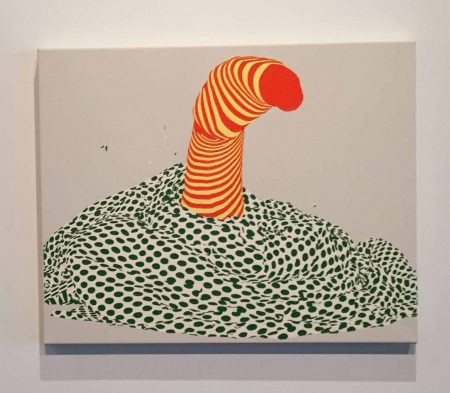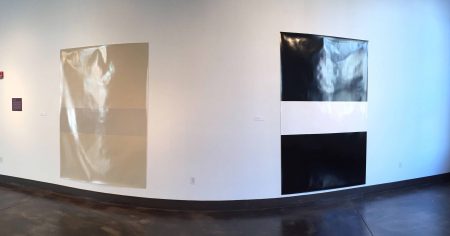Painting in the Network: Algorithm and Appropriation, which is currently up at University of Louisville’s Cressman Center for the Arts, and curated by Chris Reitz, is involved in a dialogue that has been unwrapping itself for just about forty years (and arguably since the advent of photography): how does new media (in all of its forms) interact with painting, and what is painting’s future? Painting in the Network is an exhibition about painting as well as an exhibition about labor.

Through utilizing formal painting devices such as color theory, single point perspective, and tension between surface and illusionistic space, the selected artists discuss painting. The most successful point for this exhibition is the coupling of digital compositions that recall modernist painting motifs with paintings that discuss our language, usage, and discourse around digital content. It makes for a challenging and intriguing space, and encourages dialogue between viewers.
The exhibition consists of seven artists: Siebren Versteeg, Gabriel Orozco, Cory Arcangel, Tabor Robak, Davis Rhodes, Laeh Glenn, and Alex Dodge. Not all of these artists are painters; however they all explore how the legacy of painting persists in the digital age.

Tabor Robak’s piece Darkroom (2016) is an enthralling ‘visual display produced by the execution of a moving image-generating computer program’. Darkroom combines masterful computer programming techniques (Robak designed each of the visual objects in the composition, as well as the code that determines the rules they follow) as well as the employing of chance operations— the code that Robak designed determines the interactions between the designed objects and the space they find themselves in. The end result is a visual display that recalls intergalactic space ships, laser light shows, and SMPTE color bars (the television test pattern that used to be used on analogue tvs).

Next was Alex Dodge’s work. Costaguana (Sulaco) is fun. It consists of this dizzying green polka-dot patterned fabric and an orange and yellow striped form that seems to emerge from the ‘fabric’. At first this work looks as if its digital referral is missing. Upon first glance, I assumed one of two things: it was either a 3D printed painting, or a laser cut stencil. The subject is an unidentified object, covered in some sort of fabric or material— Dodge creates his paintings by scanning objects in a 3D scanner or by inventing objects in a computer program. He then renders the ‘fabric’ in a 2D design program, and then the two objects come together in a ‘3D environment that incorporates a physics engine’; which is apparently an ‘algorithm that replicates the rules of Newtonian Physics’. In conclusion, he uses an algorithm to eliminate control over an image that he created. When the image creation is complete, Dodge cuts a stencil with a laser cutter, and then transfers paint to canvas.
Gabriel Orozco’s painting Pollock’s Drip Grid is easily one of the most impressive in the exhibition. It also embodies the mission of the exhibition, which is to discuss application and appropriation in painting. Pollock’s Drip Grid consists of a scanned image of one of Jackson Pollock’s drip paintings; which is then pixilated in a computer program. The pixilated version is then recreated with acrylic ink and acrylic paint. The end result is a painting of a digitally generated image of a painting.

Davis Rhode’s works, both titled Untitled, recalled Rothko as much as they recalled the huge industrial posters that you find in corporate clothing retail windows. Rhodes uses industrial materials to create artworks that visually recall post-war abstract painting and minimalism. Untitled was constructed by applying spray paint to the back of commercial inject printer paper. Rhode’s works link to the rest of the exhibition as he appropriates and manipulates images from commercial advertisements, thus pulling the viewer into the conversation of image consumption through digital media.
Painting in the Network carries the viewer into that all familiar space of repeatedly checking our devices for updates into the world we have curated for ourselves. One can argue that this exhibition is an exploration of actions deemed repetitive and redundant for the sake of being just those two things. Or one can argue that that same repetitiveness and redundancy holds moments of escapism, enjoyment, laughter, knowledge, and other key human experiences that are important to personal development. Either way, go see Painting in the Network. It’s a beautiful exhibition with national and internationally known artists. The show is open February 10th through April 8th.
–Megan Bickel